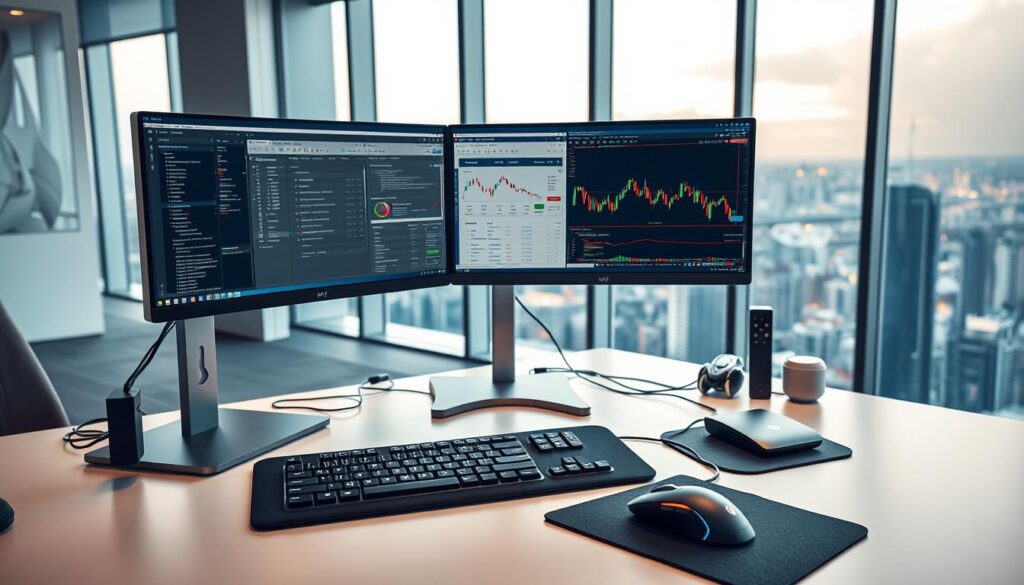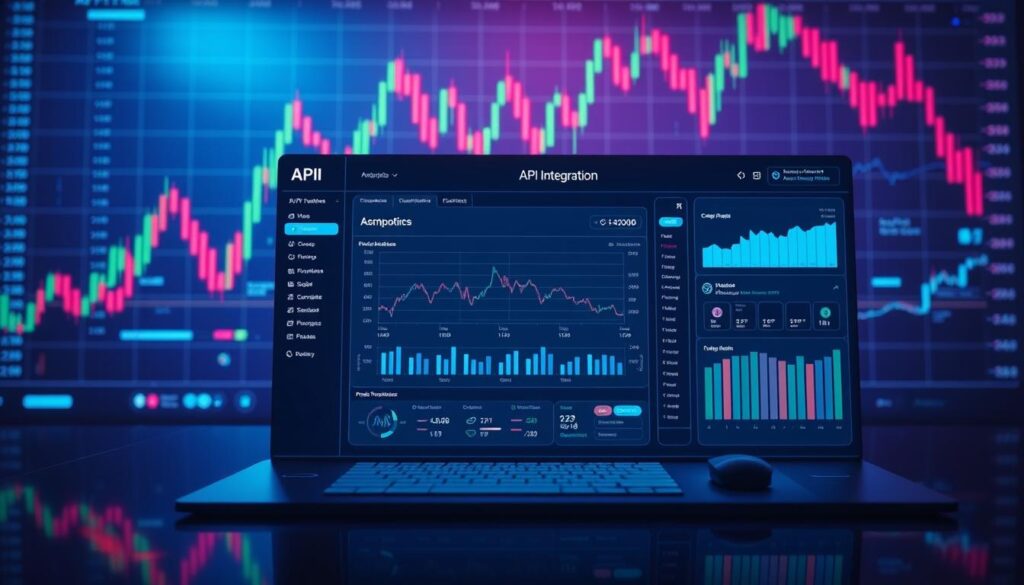The rapid growth of digital asset exchanges has reshaped financial strategies, creating demand for tools that operate with precision. Automated systems now dominate modern trading, leveraging data-driven decision-making to outperform manual approaches. These solutions thrive in environments where milliseconds determine profit margins.
Advancements in machine learning and decentralized networks have simplified the creation of sophisticated tools. Developers can now integrate real-time analysis, risk management protocols, and adaptive algorithms into their projects. This evolution has opened doors for individual traders to compete with institutional players.
Automated systems excel at identifying patterns across volatile markets. Unlike human operators, they process vast datasets without fatigue, executing strategies around the clock. For those exploring best free AI crypto trading bots, understanding core development principles becomes crucial for customization.
Key Takeaways
- Automated systems reduce emotional decision-making in volatile markets
- Modern algorithms leverage historical and real-time data analysis
- Blockchain advancements enable faster transaction processing
- Precision timing minimizes slippage in high-frequency trading
- Customizable parameters adapt to evolving market conditions
- Open-source libraries accelerate development timelines
Understanding the Evolution and Benefits of Crypto Trading Bots
The fusion of traditional finance algorithms with blockchain tech birthed a new era in trading efficiency. Over 70% of conventional stock market activity now relies on automated systems, according to recent financial analyses. These methods migrated to digital assets as crypto exchanges matured, creating tools that execute strategies with mathematical precision.
Transforming Market Participation
Early adopters required coding expertise to implement automated strategies. Today’s platforms democratize access through intuitive interfaces. This shift allows casual participants to leverage institutional-grade tactics previously reserved for hedge funds.
Round-the-clock operation eliminates geographical barriers. Systems monitor price fluctuations across time zones without human oversight. This constant vigilance captures opportunities during off-peak hours when manual traders sleep.
Precision Through Automation
Advanced algorithms process historical patterns and live feeds simultaneously. They identify entry/exit points using multiple indicators – from moving averages to social sentiment. Emotional decisions often sabotage manual strategies, while bots stick to predefined rules.
Modern solutions incorporate self-improving mechanisms through machine learning. These systems refine their approaches after each market cycle. Backtesting against decades of crypto data ensures strategies remain effective through bull runs and crashes alike.
Exploring AI and Automation in Cryptocurrency Trading
Financial markets have entered an era where milliseconds determine outcomes, driven by intelligent systems that never sleep. These technologies analyze global shifts faster than any human, transforming speculative moves into calculated actions. Their evolution stems from merging computational power with pattern recognition techniques refined over decades.

Role of Artificial Intelligence in Trading
Modern systems decode market chaos using neural networks trained on petabytes of historical data. They spot subtle correlations between asset prices, news cycles, and blockchain activity. Unlike static algorithms, these tools adapt strategies based on live feedback loops.
Machine learning models excel at predicting volatility spikes before they appear on charts. They process social sentiment from forums and news outlets, weighing public emotion against numerical trends. This dual analysis creates risk-adjusted strategies that outperform rigid rule sets.
Automation Benefits for 24/7 Market Operations
Digital asset exchanges never close, demanding constant vigilance from participants. Automated solutions thrive here, executing trades during Tokyo lunch breaks or New York midnight hours. They bypass human limitations like fatigue or hesitation during flash crashes.
Real-time order matching ensures optimal entry points even when markets swing wildly. Systems monitor dozens of exchanges simultaneously, capitalizing on fleeting price differences. For those exploring essential components for automated trading systems, integrating robust APIs becomes critical for latency-sensitive operations.
Emotion-free execution prevents panic selling or FOMO-driven buys. Parameters set during calm periods remain enforced during turbulence, locking profits and minimizing losses. This discipline separates successful strategies from reactive gambling.
How to build AI trading bot for cryptocurrency markets programming tutorial
Effective automated systems begin with purposeful design rather than random code experiments. Defining operational parameters early creates alignment between technical capabilities and financial ambitions. This phase determines whether your solution becomes a precision instrument or an expensive experiment.

Setting Clear Objectives for Your Bot
Three primary approaches dominate automated trading: rapid-fire arbitrage, short-term scalping, and position-based investing. Each requires distinct data pipelines and decision trees. Arbitrage bots need multi-exchange connectivity, while long-term systems prioritize macroeconomic indicators.
Capital allocation and risk thresholds shape technical requirements. A $500 portfolio demands different safeguards than a $50,000 investment. Time horizons affect algorithm complexity – minute-by-minute trading needs faster APIs than weekly rebalancing.
| Strategy Type | Timeframe | Risk Level | Tools Required |
|---|---|---|---|
| Cross-exchange arbitrage | Seconds | Medium | Multi-platform API integration |
| Scalping | Minutes | High | Low-latency order execution |
| Trend following | Days/Weeks | Low | Historical pattern recognition |
Backtesting against historical crashes reveals strategy resilience. A 2021 Bitcoin flash crash simulation might show whether stop-loss triggers function during liquidity droughts. These stress tests prevent real-world disasters.
Documenting performance benchmarks allows iterative improvements. Successful systems balance ambition with technical feasibility – chasing 10% monthly returns often creates unstable code. Realistic goals foster sustainable development cycles.
Key Components and Features of a Successful Trading Bot
Modern trading systems thrive on three pillars: data interpretation, strategic execution, and loss prevention. These elements work together to transform raw market activity into profitable actions. Sophisticated tools balance speed with accuracy, adapting to sudden price shifts while maintaining operational stability.
Market Data Analysis and Signal Generation
Real-time processing separates effective systems from outdated models. Advanced solutions crunch price histories, social chatter, and order book changes simultaneously. They detect patterns using indicators like Bollinger Bands or RSI, flagging opportunities humans might miss.
| Analysis Type | Key Indicators | Purpose |
|---|---|---|
| Technical | MACD, Moving Averages | Identify chart patterns |
| Sentiment | Social media trends | Gauge market mood |
| Fundamental | Exchange reserves | Assess asset health |
Order Execution and Risk Management Features
Speed matters when acting on signals. Reliable systems place limit orders faster than market fluctuations erase profits. They manage exposure through automatic position sizing and preset stop-loss triggers.
Successful platforms integrate multiple safeguards. Take-profit levels lock gains during volatility spikes. Dynamic adjustments prevent overcommitment during uncertain periods. These features create disciplined operations immune to emotional trading.
Choosing the Right Programming Language and Development Tools
Programming language choice directly impacts a trading system’s efficiency and scalability. Three options dominate automated solutions, each offering unique advantages for different operational needs. Selection criteria should balance speed requirements, development timelines, and long-term maintenance considerations.

Balancing Speed and Accessibility
Python leads in developer adoption due to its intuitive syntax and rich ecosystem. Libraries like Pandas streamline data processing, while TensorFlow enables machine learning integration. Rapid prototyping capabilities make it ideal for testing strategies outlined in advanced trading strategies before deployment.
Java excels in enterprise environments requiring rock-solid stability. Its virtual machine architecture ensures consistent performance across platforms. Financial institutions favor this language for handling high-volume transactions with minimal downtime.
C++ remains unmatched for latency-sensitive operations. Direct memory access and optimized compilation enable microsecond-level execution. While demanding greater coding expertise, it’s essential for arbitrage systems competing on speed.
- Python: Quick iteration with extensive AI/ML libraries
- Java: Cross-platform reliability for institutional use
- C++: Raw speed for high-frequency trading
Development environments enhance productivity across all languages. PyCharm simplifies Python debugging, while IntelliJ streamlines Java project management. Visual Studio provides C++ developers with advanced optimization tools for performance tuning.
Integrating Exchange APIs and Real-Time Market Data
Seamless connectivity between automated strategies and live markets forms the backbone of modern trading systems. Selecting the right platforms requires balancing technical capabilities with operational reliability. Three critical factors guide this decision: liquidity depth, API stability, and security protocols.

Leading platforms offer distinct advantages for different strategy types. High-frequency operations demand robust infrastructure, while long-term systems prioritize regulatory compliance. Below we analyze top exchanges through a developer’s lens:
| Exchange | Key Strength | API Features | Best For |
|---|---|---|---|
| Binance | Market depth | 500+ pairs, WebSocket | High-frequency strategies |
| Coinbase | Regulatory compliance | FIX protocol | Institutional-grade systems |
| Kraken | Security architecture | Margin trading endpoints | Advanced order types |
Accessing Liquidity on Binance, Kraken, & Coinbase
Binance dominates volume metrics, offering minimal slippage for large orders. Its API supports historical data downloads alongside real-time feeds – crucial for backtesting models. Developers appreciate detailed documentation with code samples in Python and JavaScript.
Coinbase prioritizes institutional needs through insured custodial wallets and audit trails. While supporting fewer assets, its data integrity satisfies compliance-focused operations. Kraken’s security layers include multi-factor authentication and encrypted key storage, appealing to risk-averse users.
Effective integration requires:
- Authentication via API keys with IP whitelisting
- WebSocket connections for instant price updates
- Fallback mechanisms during exchange downtime
- Rate limit monitoring to avoid service bans
Third-party data providers supplement exchange APIs during volatile periods. Services like CryptoCompare aggregate feeds across platforms, ensuring uninterrupted market visibility. This redundancy prevents strategy disruptions when primary sources lag.
Implementing Risk Control and Ensuring Security
In the high-stakes world of digital asset management, safeguarding investments requires more than basic protocols. Secure wallet integration forms the foundation of reliable automated systems, ensuring assets remain protected during volatile market shifts. Modern solutions leverage AI-enhanced wallets that automatically adjust storage protocols based on threat detection.
Stop-Loss Triggers and Asset Protection
Predefined exit strategies prevent catastrophic losses during sudden price drops. Systems using TRC20 or XDC crypto wallets integrate directly with trading platforms, enabling instant transfers when risk thresholds breach. Automated take-profit orders lock gains without emotional interference, while multi-signature approvals add transaction security.
Evolving Defense Mechanisms
Cyber threats constantly adapt, demanding weekly code audits and real-time vulnerability scans. Developers should implement HTTPS encryption for API communications and hardware-secured key storage. Regular backups to cold wallets ensure asset recovery if primary systems fail.
Successful risk management balances aggressive profit targets with fail-safe protocols. By combining smart contract verification with behavior-based threat detection, systems maintain operational integrity through market turbulence. These practices transform experimental tools into trustworthy financial partners.


No comments yet